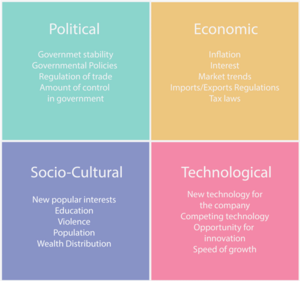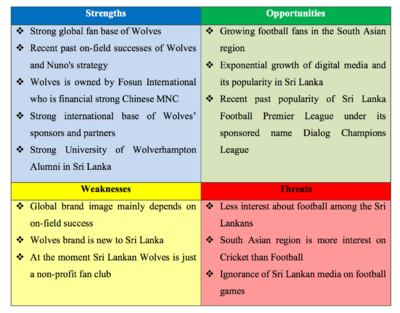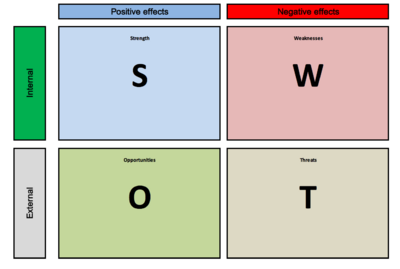SWOT analysis in project management
Written by Baptiste REDON, March 2022
SWOT analysis is a common used tool in project management. It was developed by Harvard economists during the 1960s. This method is very powerful for all types of projects if it is applied correctly. Indeed, it is a strategic business analysis tool that combines the study of the strengths and weaknesses of a project with the opportunities and threats of its environment, in order to help define a development strategy. They are known as internal and external factors. [1] [2]
SWOT stands for Strengths, Weaknesses, Opportunities and Threats. These are the four key areas to be identified and assessed in order to develop an efficient business or project. The SWOT analysis usually ends up by building a matrix 2 by 2 where each cells corresponds to an area. Other tools such as the PEST method [3] could be associated with the SWOT analysis in order to have a broader view of the assessment of threats and opportunities.
In this Wiki article, you will find information on how to use this powerful tool in project management and under which circumstances as well as an example to show how to use the SWOT analysis in an efficient way.
Contents |
The theory of SWOT Analysis
Why do we use a SWOT Analysis ?
The SWOT method is mainly used during the early stage of a project in order to analyze the situation. It combines the analysis of the current state with the analysis of the future state. Indeed, we start by identifying the strengths and weaknesses (internal point of view) and the opportunities and threats (external point of view). Then, by analyzing the matrix, we are able to get a better view of the future state of the project.
The SWOT matrixes are usually performed for different purposes in companies. Here is a list of some area of applications [4] :
- Performance analysis : To identify and to measure the influence of the internal operations and the external impacts on how the company is performing
- Situation analysis : To assess internal and external conditions affecting the company at the beginning of a project
- Cause analysis : To evaluate what tools need to be developed and what methods should be improve
- Business analysis : To identify markets opportunities and threats and find how to deal with it.
The use of the SWOT analysis is not only limited to companies as it can be used for any type of project (professional or personal). For instance, you can do a SWOT matrix for yourself to prepare for a job interview or when you are planning a road trip.
When do we use a SWOT Analysis ?
In a system-oriented problem solving project, there are several steps divided on the outcome of each phases [4] :
- Situation analysis : The goal of this first step is to clearly identify the issue and to frame the project. Gathering data, identifying factors that may influence the project, analyzing the current state and predicting the future state are among the main tasks.
- Goal definition : The outcome of this phase is to clearly define objectives for the project. At the end of the first two steps, the project should be framed and the issues to solve identified.
- Searching for solutions : During this phase, the project team should elaborate potential feasible solutions by brainstorming and then conducting data-driven analysis to see if it is feasible.
- Selection : The end phase of the methodology of system-oriented problem solving consists on making a decision by elaborating a set of criteria and assessing each potential solutions.
SWOT analysis is used in the situation analysis phase to analyze the current state and to predict the future state. It is usually one of the last tool used during this phase after demarcating the system, analyzing the stakeholders and gathering data. The figure 1 shows when to apply the method in the system-oriented problem solving process.
Assessing the factors
The first step of SWOT analysis consists of assessing the four factors [1] : Strengths, Weaknesses, Opportunities and Threats. The first two factors are internal : they are depending only on the company. As an analogy with a personal SWOT matrix, they correspond to the qualities and defaults of the person. On the contrary, opportunities and threats are external. As examples, those external factors can be governments policies, a new concurrent rising, new business opportunities or even a worldwide pandemic such as the COVID-19 crisis.
Internal factors
Strengths
The strengths are the positive internal aspects that the company can control. As an example for a company, it could be high quality products, a worldwide implementation or a dynamic and experienced project team.[1]
Usually, you can identify your strengths by collecting data from inside and outside the company. In order to assess the strengths, here are some questions that could generate global ideas[2] :
- What are your advantages ?
- What are your forces according to an external point of view ?
- Do you possess unique resources and what are they ?
Weaknesses
On the contrary, weaknesses are the negative internal aspects that the company can control. They have usually a huge potential to be improved if time and money are provided. For instance, a bad communication leading to less visibility or a lack of financial stability could be considered as weaknesses. [1]
As for strengths, weaknesses are usually identified by collecting data. To get ideas, here are some questions that you could answer [2]:
- What could you improve ?
- Where do we have less resources than the concurrent ?
- What are you not doing well ?
External factors
Opportunities
Opportunities are the positive external effects that can be taken advantage of in the context of current strengths and weaknesses. They develop outside the project’s sphere of influence or at the margin. For instance, a change in global consumer tastes regarding a country's production, economy growth of a country where you to implement or the development of online shopping can be considered as opportunities. [1]
Threats
Threats are external problems, obstacles or limitations that can prevent or limit the development of the project. As opportunities, threats are often outside the project’s sphere of influence or at the margin. As examples, we can take the loss of interest of customers for a product or the COVID-19 worldwide pandemic for the majority of companies.[1]
A tool for assessing external factors : PEST analysis

In order to assess those external factors, we can use the PEST analysis method. The goal of this tool is to identify potential external factors. Thus, it is very useful for the assessment of opportunities and threats in the SWOT analysis. PEST stands for Political, Economic, Social and Technological. PEST methods focuses on those four areas [3] :
- Political : All factors that are related to policies and laws. For instance, we can take taxes, employment or a new law regulating the market of the company.
- Economic : Factors that may affect the economy of the company. For example, taxes, inflation or economic growth of a country can be either a threat or an opportunity for the company.
- Social : These factors are mainly related to the customer behavior. As an opportunity, we can take the example of a young generation willing to try new things for the development of an extreme sport whereas a social threat could be the fear that it provokes to potential customers. It can also be related to the country with the education system and its own culture.
- Technological : These factors are related to the scientific point of view. For instance, the level of innovation in the company and its R&D activity can be either an opportunity if it is well developed or a threat if it is the contrary.
A template of the PEST analysis is shown in figure 2. There is also more and more people that are adding two areas of analysis : Environmental and Legislation.[3] By using this tool and its structure, you will be able to find threats and opportunities for your project.
Matrix building
When the assessment of the four factors are done, the next step is to build the matrix. Its shape is a 2 by 2 where each cell corresponds to one factor. A template is shown in figure 3. You can stop the SWOT analysis after building the matrix but it will be only a partial analysis. Many companies are using this tool just to enunciate the different factors and they are not combining it together. As a result, they get more a description than a real analysis. The main advantages of doing only a partial SWOT analysis are the gain in time and the fact that we assess only one factor at a time, leading to a better understanding of the context. However, a partial SWOT is not really an analysis as it forgets the last step.[1]
Analyzing the matrix
After assessing the different factors, we have a clear view of the strengths, weaknesses, opportunities and threats. The last phase of the SWOT analysis methodology is the combination of the factors in order to prepare for the next step of the project, which is defining clear goals.
Before starting the analysis, you should take only the most important factors you found in the previous steps. Due to combination, the amount of factors is important and no more than 4 of each is generally good to conduct the analysis.
Then, the analyze is made by combining both internal and external factors. There are four different combinations [1] :
- Strengths and Opportunities : use strengths to promote and to develop an opportunity.
- Strengths and Threats : use strengths to avoid threats to happen or to minimize its potential effects
- Weaknesses and Opportunities : exploit the opportunities to address weaknesses and improve the company
- Weaknesses and Threats : Address the weaknesses in order to avoid threats to happen and minimize its potential effects.
For each of those four combinations, you can build a matrix as shown as in the figure 4. The icon “+” means that you can combine the strength and the opportunity whereas a “0” indicates that it is not possible. In the example of figure 4, strength 1 can be used to promote opportunities 1, 2, 4, 5, 6, 7, 9 and 10. The same matrix can be made with the three other combinations. After that, there will be numerous possible actions and you need to choose which one you want to apply.
By combining the internal and external factors, you get a better view of the project and you know where are the potential improvements to make. Usually, after matching the factors, you make evaluations to identify all the issues which will help in the future when it comes to the decision making process (last step of the project) [1].
Example : Development of a football fan club in Sri Lanka
Let’s see how to do a SWOT analysis on a concrete example taken from the report “A three-year marketing plan for the Sri Lankan Wolves”. It was written by Subasgar Kumareswaran. The example is focusing on a marketing point of view, but what is important is to see how the tool is used.
Situation
Sri Lankan Wolves are a student fan club of the Wolverhampton Wanderers, and they are wishing to develop their association in Sri Lanka. Wolverhampton Wanderers is a famous football club in the English premier league. In order to develop and to expand their image in Sri Lanka, Subasgar Kumareswaran made a SWOT analysis. [5]
Assessing the factors
Strengths
- Good results : Wolverhampton is a successful football club in one of the most competitive championship in the world. This leads to a better visibility of the club.
- Strong fan base : The club has a wide range of fans all around the world which can reinforce the interest of Sri Lankan fans.
- Financial Stability of the club : The owner of the club is one of the richest Chinese conglomerate (Fosun International) and they are willing to develop their image in Asia. Furthermore, Wolverhampton has sponsor deals with a lot of multinationals which could help to develop their attractiveness in Sri Lanka. That would be a win-win agreement.
- Partnership with a university : At last, the University of Wolverhampton has a partnership with two universities in Sri Lanka and they are relying on the Alumni to spread the brand to the Sri Lankans.[5]
Weaknesses
- Dependence of the on field success : The development and the visibility depends strongly on the success of the football club. Thus, there is an unpredictable pattern that can appears.
- Wolves are new comers in Sri Lanka : The fan club Sri Lankan Wolves is recent and is struggling to get more visibility. Wolves are a new brand in a difficult environment (Sri Lankan are preferring cricket to football)
- Non-profit fan club : There is no profit made by the Sri Lankan Wolves, which prevent them to organizing expensive events.[5]
Opportunities
- Development of football in South East Asia : Football becomes more and more popular in the area especially after the World Cup 2018. The Football Federation of Sri Lanka are investing to build a better national team in order to compete with the other countries in the region.
- Growth of digital media in Sri Lanka : Young people are using and getting informed by digital media, and the growth of this type of media could help the Sri Lankan Wolves to reach more people and thus gaining in visibility.[5]
Threats
- Sri Lankan lacks of interest : One of the biggest threats is the preference of the cricket instead of football in Sri Lanka. Even though, there is a more and more interest, the national sport is still cricket.
- Media ignorance of football : Media in Sri Lanka are focusing on other sports such as rugby and cricket instead of football. This could leads to difficulties to find new fans and to expand the Wolves brand.[5]
Moreover, a PEST analysis has been made where other opportunities and threats were identified from a political, economic, social and technological perspective. However, Subasgar Kumareswaran decided to separate both analysis, but it is possible to mix them in order to get more opportunities and threats to the development of the Wolves brand.
Matrix building
Now that all of the factors had been identified, the next step is to build the matrix. It is shown in the figure 5.

Limitations
SWOT analysis can be a very powerful tool for situation analysis but there are also several limitations written in the article “Fuzzy SWOT analysis” by S. Ghazinoory, A. Esmail Zadeh and A. Memariani as well as in the “Handbook of Improving Performance in the Workplace: Selecting and Implementing Performance Interventions” written by R.Watkins and D.Leigh.
The most important issues identified are [4] [6] :
- The factors are not ranked, and thus, there are no possibilities to prioritize one factor prior to another one
- Usually, it is limited to a qualitative analysis. It is more the case for threats and opportunities as collecting data could be challenging for external factors.
- Sometimes, the same factor could be in opportunities and threats (example : COVID-19) and there is a lack of explanation of this contradiction in the matrix
- There are no restrictions on the number of each factors and thus, there are a lot of possible combinations consuming a huge amount of time
In order to solve some of the issues, another method of SWOT analysis had been thought. It is explained in the article “Fuzzy SWOT analysis” where they are trying to put ratios on the factors. For example, the COVID-19 pandemic could take the value of 0.2 as an opportunity and 0.8 as a threat. This leads to the fact that the SWOT analysis considers the factors uncertainty in the assessment, and thus increase the effectiveness of the tool [6].
SWOT analysis is a powerful tool in project management to assess and analyze qualitatively both internal and external factors. It is very visual and the combination of the different factors bring a better overview of the project.
Annotated bibliography
1. R. Watkins and D. Leigh, Handbook of Improving Performance in the Workplace: Selecting and Implementing Performance Interventions, Vol. 2 (2010), Pfeiffer, pp. 115–140
The "Handbook of Improving Performance in the Workplace: Selecting and implementing Performance Interventions" written by Ryan Watkins and Leigh Doug is a book explaining how to improve organisational performances in companies. The theory of SWOT analysis and the are well described.
2. Subasgar Kumareswaran, A three-year marketing plan for the development of the Wolves brand in Sri Lanka, pp. 4-8, 2019
“A three year marketing plan for the development of the Wolves brand in Sri Lanka” is the final assignment report of Subasgar Kumareswaran to the Master Degree of Business Administration at the University of Wolverhampton. In this report, he investigated to do a marketing plan to develop the visibility of the Sri Lankan Wolves, a student fan club. The first pages were providing this innovative SWOT analysis example used in this article.
3. H. Weihrich, The TOWS matrix - a tool for situational analysis, Vol.15 (1982), J. Long Range Plan, pp. 54-66
« The TOWS matrix – a tool for situational analysis » by Heinz Weihrich is one of the first article to clearly define the SWOT analysis (TOWS and SWOT are the same) and how to use it in strategic planning. It is a core reference in this domain and it has been used in this article to explain the theory of the SWOT analysis.
4. S. Ghazinoory, A. Esmail Zadeh and A. Memariani , Fuzzy SWOT analysis, Vol.18 (2007), Journal of Intelligent & Fuzzy Systems, pp. 99–108
The “Fuzzy SWOT analysis” written by S. Ghazinoory, A. Esmail Zadeh and A. Memariani is an article published in the Journal of Intelligent & Fuzzy Systems. This article tackles the defaults of the common used SWOT matrix in the industry and elaborates a potential solution using the fuzzy theory.
References
- ↑ 1.0 1.1 1.2 1.3 1.4 1.5 1.6 1.7 1.8 1.9 H. Weihrich, The TOWS matrix - a tool for situational analysis, Vol.15 (1982), J. Long Range Plan, pp. 54-66
- ↑ 2.0 2.1 2.2 Will Kenton, Strength, Weakness, Opportunity, and Threat (SWOT) Analysis, 2021, external link: [1] Retrieved March 22 2022
- ↑ 3.0 3.1 3.2 3.3 Dan, PEST Analysis, 2016, external link: [2] Retrieved March 22 2022
- ↑ 4.0 4.1 4.2 R. Watkins and D. Leigh, Handbook of Improving Performance in the Workplace: Selecting and Implementing Performance Interventions, Vol. 2 (2010), Pfeiffer, pp. 115–140
- ↑ 5.0 5.1 5.2 5.3 5.4 5.5 Subasgar Kumareswaran, A three-year marketing plan for the development of the Wolves brand in Sri Lanka, pp. 4-8, 2019
- ↑ 6.0 6.1 S. Ghazinoory, A. Esmail Zadeh and A. Memariani , Fuzzy SWOT analysis, Vol.18 (2007), Journal of Intelligent & Fuzzy Systems, pp. 99–108

